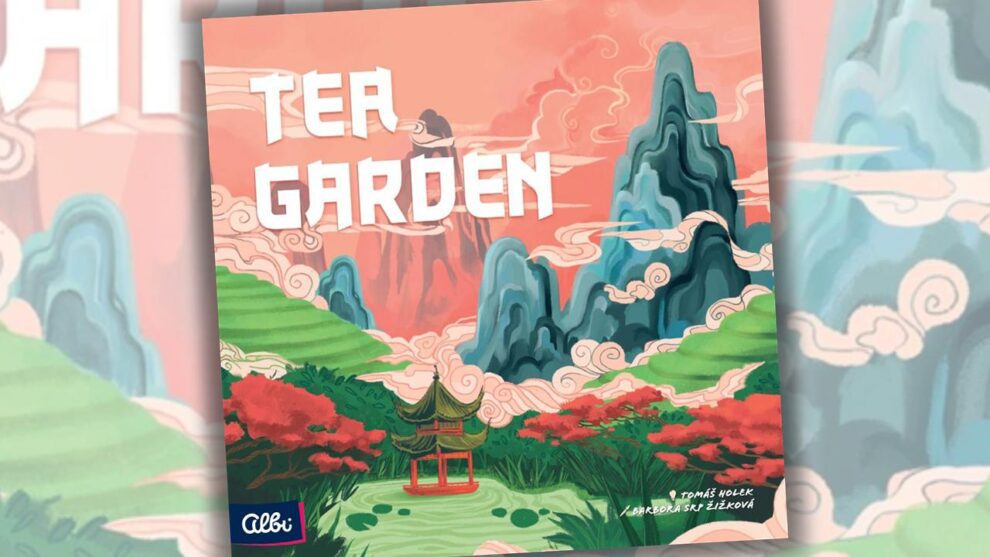Disclosure: Meeple Mountain received a free copy of this product in exchange for an honest, unbiased review. This review is not intended to be an endorsement.
Varia-tea is the Spice of Life
Tomáš Holek has been on a roll lately. Between last year’s breakout hit SETI: Search for Extraterrestrial Intelligence and Galileo Galilei earlier this year, the titles just keep coming. It’s impressive to see how quickly Holek releases new designs while maintaining both unique themes and consistent gameplay quality.
Tea Garden transports players to 8th-century China during the Tchang Dynasty—a time when tea culture spread widely across the country, with roots in the Yunnan region. As with his previous work, Holek steeped his design in rich historical flavor, wrapping thoughtful mechanics around the process of tea cultivation and export. This fits nicely along the trend of tea-themed games.

This midweight Euro economic game blends deckbuilding, resource management, tech tracks, contract fulfillment, and a few other flavors into a smooth, herbal mix. Compared to the more robust SETI: Search for Extraterrestrial Intelligence, Tea Garden is a touch lighter in complexity. Brought to the U.S. by Capstone Games, Tea Garden makes its debut at GenCon 2025, carrying over the strong buzz it generated at Spiel last year.
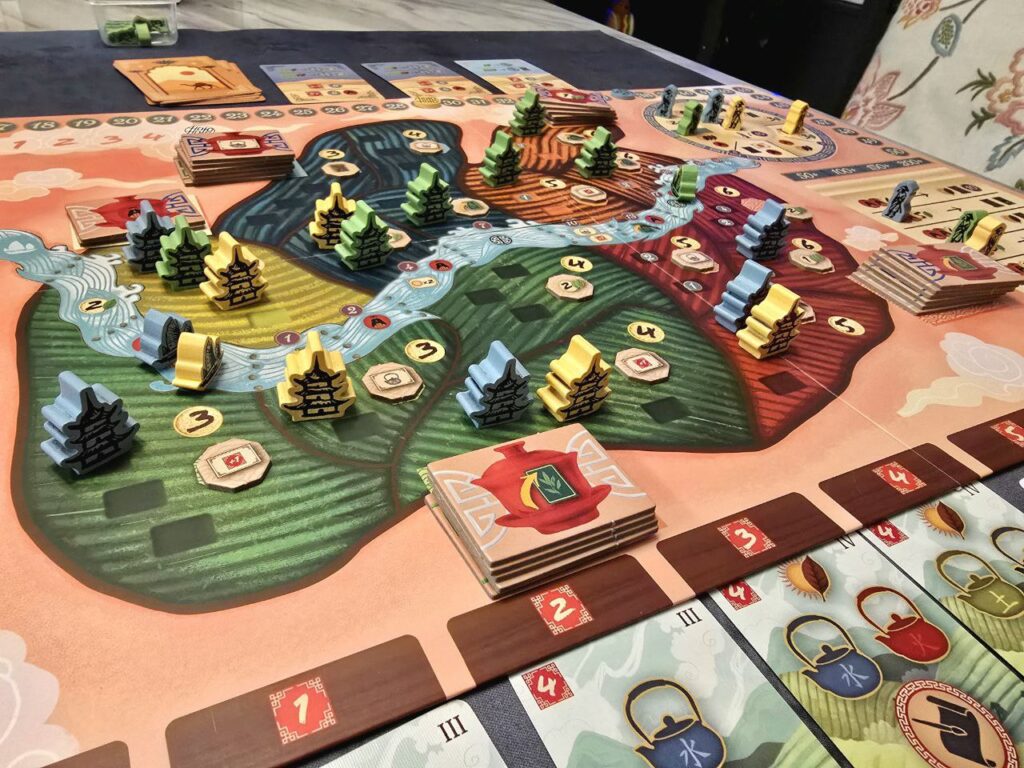
The Blend of Mechanics
Tea Garden is played over five rounds, where the highest points wins. Players will accumulate tea leaves on their ripe, green side, and the quality of tea leaves ranges from one to six. Players start with an identical deck of cards and players will play cards to perform an action to the card’s strength, up to four turns per round.
Each card has a printed number value, and the total sum of the card’s strength will dictate what actions can be taken. Players are also able to perform a secondary action if the symbol appears on the top-most played card. Actions include building a tea garden in an adjacent region, buying an action card, selling tea to caravans (contracts), fermentation (aging tea leaves from the green ripe side to the more powerful fermented brown side), and extra leaf harvest (allows an immediate production phase. If the matching symbol is uncovered, players can take secondary actions, which include moving on a rondel or the river (both allowing extra resources/actions) or the “cup” action. The cup action grants the player a cup tile, and if they can match the color symbol, they can get something juicy (resource/action) out of it as a free action.
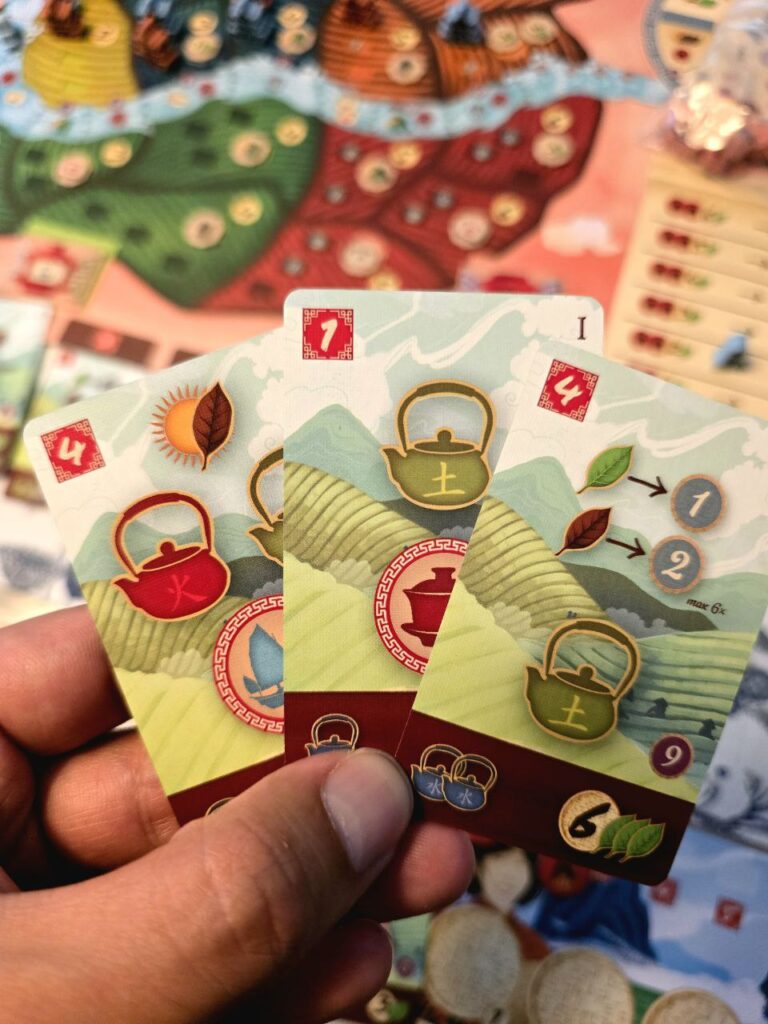
Other free actions include moving up the Emperor track, which requires spending some amount of tokens/resources to gain powerful multi-symbolized emperor cards, which also adds additional end-game scoring conditions. The last free action is being able to repeat a secondary action at the cost of fermented leaves.
A player can optionally take a fourth turn in a round, but it will cost several tea leaves to do so.
Once all players have passed, the maintenance/harvest phase kicks off, where players’ tea leaves will degrade in quality (if ripe) or increase in quality (if fermented). Players will also produce new tea leaves based on the amount and region of their tea gardens. Final scoring is the total of card points, river/emperor/tea study track placements, and the total number of matching colored cups.
A Bit Lukewarm
The theming in this game is top-notch. It almost feels like what Viticulture is to wine, Tea Garden is to tea. The mechanics are tightly woven into the theme—harvesting fields, currying favor with the emperor through export, and watching tea leaves degrade over seasons. By the end, I felt like I could brew a hot cuppa from scratch.
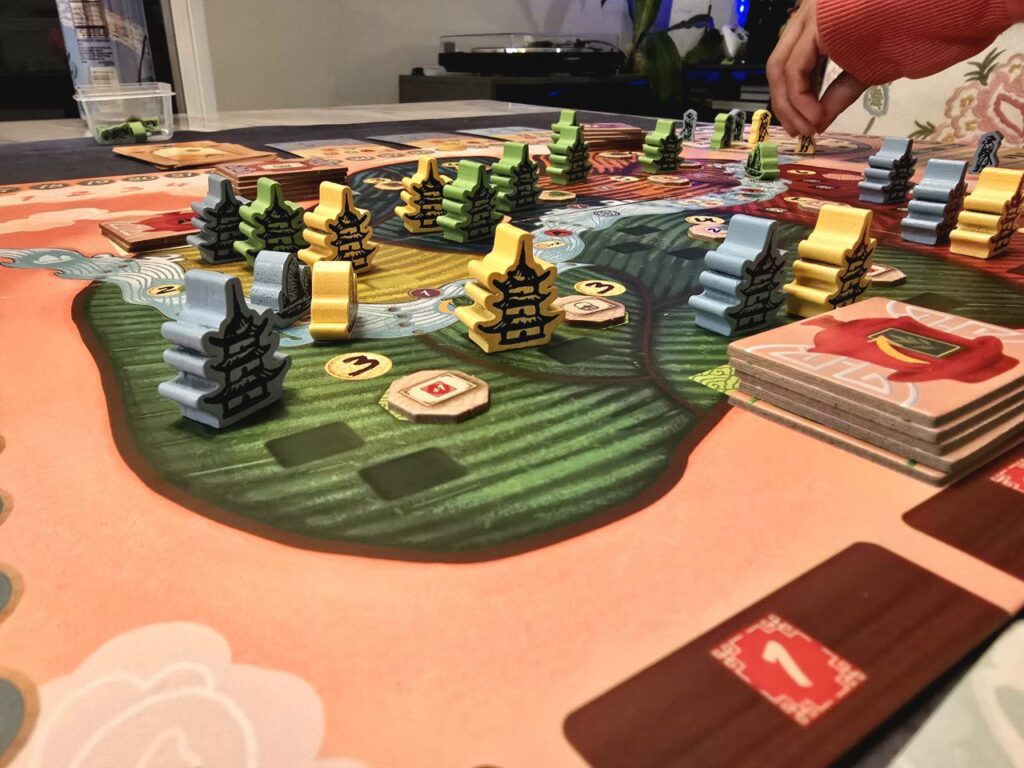
However, the game does have a bit of a shortfall. The mechanics aren’t particularly new or innovative, and that’s okay. Many players will feel, “Oh, this is just like game X or Y.” The two that stuck out most to me were Concordia and Viticulture. What matters more is how those mechanics are fleshed out. Unfortunately, many of the systems—while familiar—tend to crescendo into a fizzle rather than a bang. Though interconnected, the gameplay feels more like a tea sampler of mechanics than a full-bodied brew. Some turns offer exciting combos that go on and on, while others produce just a single mediocre action.
There are many routes to victory, and like many smart Euro designs, you can’t do it all. Players will usually commit to one or two—maybe three—paths and try to optimize from there. Teeing up the right action cards with matching secondary symbols can yield big points, but you’ve got to lean in hard to make it worthwhile.
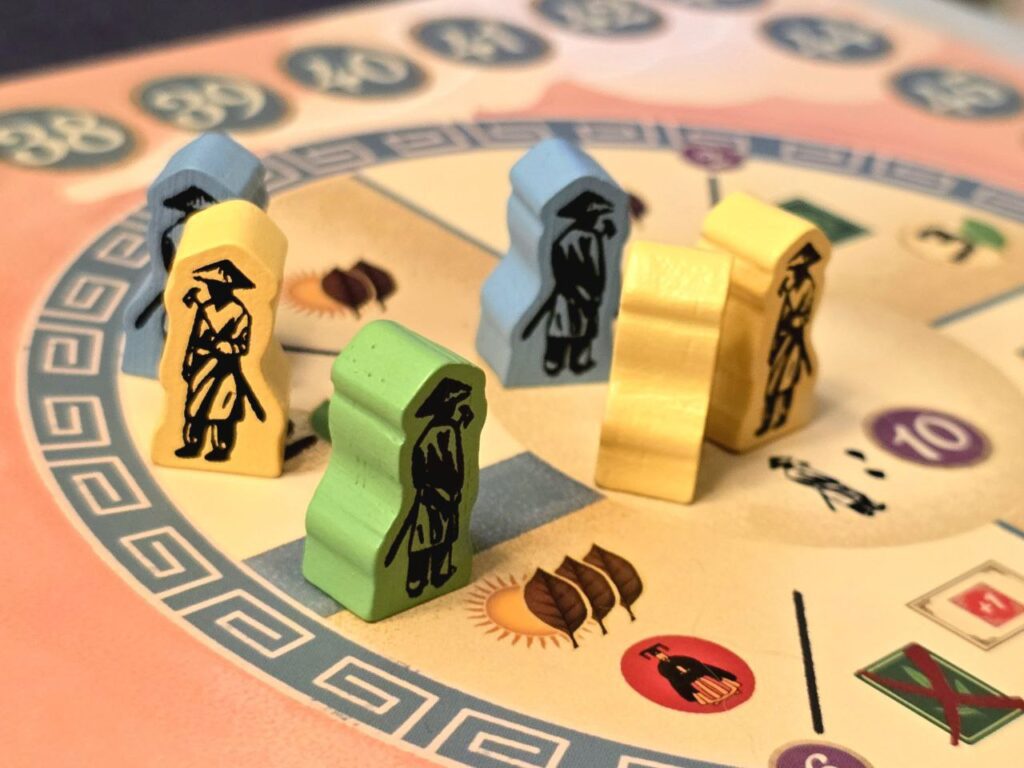
And while I love the deckbuilding aspect (new cards go straight into your hand!), your success depends heavily on it. If your deck or hand is full of slop, you’ll fall behind quickly as actions become more expensive. A poor first draw can skunk your entire first round, which is brutal in a five-round game. You may find yourself forced to spend an entire turn just to draft a stronger card to stay competitive. But buying cards is tough: you need the right action point total, the right tea leaves, and the right color pot. At most, you’ll buy one—maybe two—cards a round if you’re lucky. It’s hard to say if this is good or bad… so I’ll just say both. On the plus side, the game is generous with deck culling, spreading those actions as bonuses across the board.
Tea Garden follows in Galileo Galilei’s footsteps with its near-zero player interaction. There’s a bit of a race along the river for diminishing rewards, and players can snipe the juiciest card or contract, but you’re never blocked from taking an action. Some regions on the map are space-limited, which could be interesting, but even at max player count, we never filled the map.
As you journey across the land, it always feels like you’re teeing up for the next turn. You do X action to prep for Y so you can finally do Z, and repeat. The engine-building, such as it is, comes mostly from your deck—but even then, it never feels like it runs efficiently. It’s a jack-of-all-trades, mechanically, master of none. And while I genuinely enjoy all of these mechanics, there are other games that simply do them better.
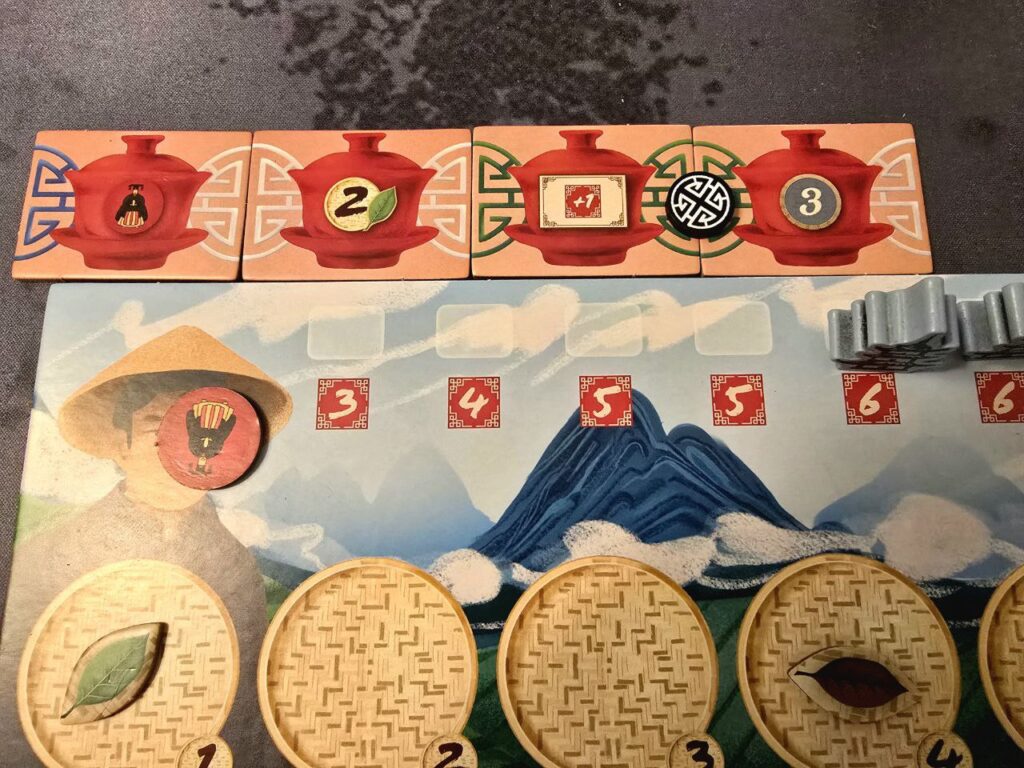
That said, it’s not all bad vibes. The game runs smoothly and snappily. Downtime is practically nonexistent thanks to quick turns (until someone pulls a wombo-combo). At all player counts, our games clocked in under an hour. My wife and I even finished a two-player game in about 30 minutes. It’s easy to pull out for a quick midweight Euro, and it never overstays its welcome.
Still, Tea Garden ultimately feels like a collection of pleasant ideas that don’t quite steep long enough to become something bold or memorable. For all its polish and potential, the game lands in the middle of the pack—a well-crafted blend of Euro staples that lacks a defining flavor to stand out. It’s enjoyable, sure. But in a crowded field of economic Euros with stronger engines, deeper interaction, or more compelling innovation, this one fades into the background.
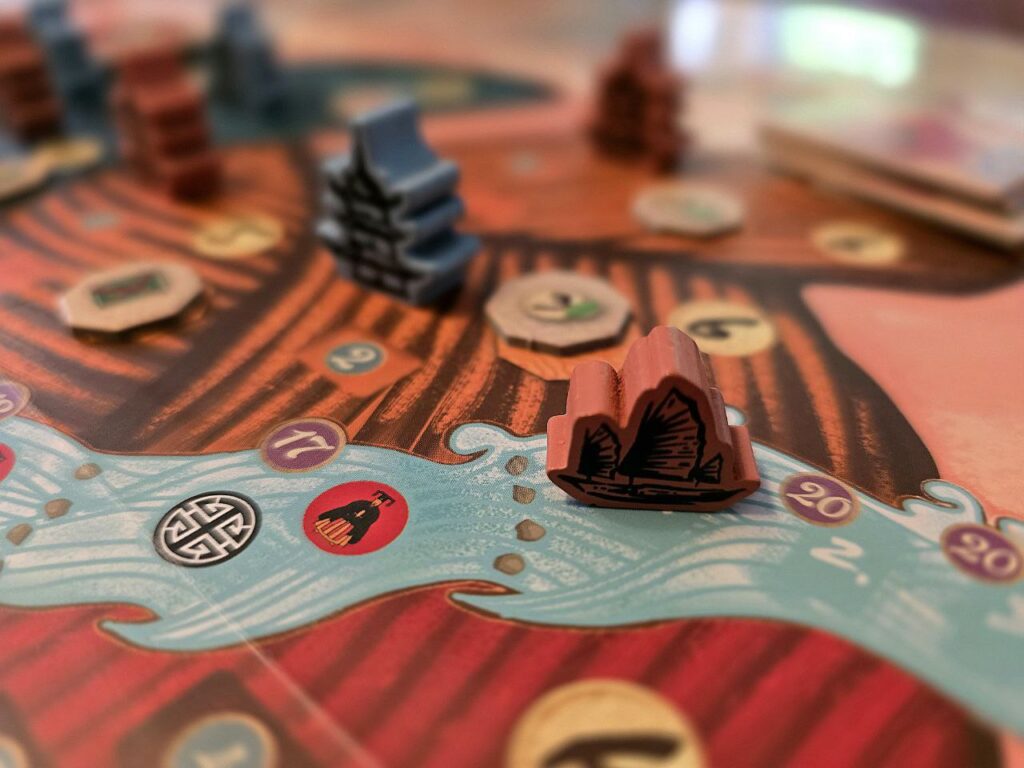
There’s no denying Holek’s talent—Tea Garden proves he can deliver consistently thoughtful designs. But while this particular brew is warm and inviting, it might leave seasoned gamers craving a stronger cup.


